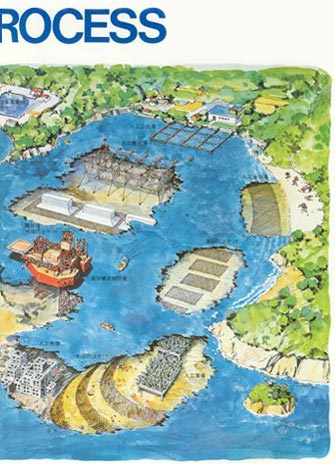| Accretion / biorock process: coral reef restoration and shore protection Mineral accretion technology is a method which uses safe, low voltage electrical currents through seawater, causing dissolved minerals to crystallize out on structures, growing into a white limestone similar to that which makes up coral reefs and tropical white sand beaches. This material has a strength similar to concrete. It can be used to make growing artificial reefs on which corals grow at very rapid rates because the change in the environment produced by electrical currents speed up formation and growth of both chemical limestone rock and the skeletons of corals and other shell-bearing organisms. (article continued below, accretion process drawing produced by Mitsui Engineering & Shipbuilding Co. of Japan, illustrating accretion technology applications and concepts developed by Wolf Hilbertz ") |
|
 |
 |
Mineral accretion methods are the best to speed up coral growth in damaged areas and restore authentic coral reef habitat and species. Coral reefs can often be restored even in areas where water quality would prevent their recovery by any other methods. Mineral accretion structures become rapidly colonized by a full range of coral reef organisms, including fish, crabs, clams, octopus, lobster, sea urchins. Species typical of healthy reef conditions are given an electrical advantage over the organisms which overgrow them in reefs stressed by humans, e.g. algal overgrowth. The metabolic advantages corals gain from mineral accretion are reduced once the current is completely cut off. Mineral accretion structures are attached onto hard bottom, providing a physical barrier to waves which slowly grows larger and stronger. An unusual feature of mineral accretion materials is that if a section is damaged by waves, rocks, or ships, the cracks will be first filled in as long as the current flows, making them self-repairing structures. They also have tremendous potential for making breakwater structures which get stronger with age, and for producing limestone structural building materials that can be grown in the sea, replacing the mining of living reefs for limestone in many countries. Accretion is very versatile since it can be powered by a large range of electrical sources including chargers, windmills, photovoltaic, and tidal current generators. Most areas where mineral accretion would be useful for reef restoration, shore protection, or material production are remote from electrical power, but mineral accretion is ideally suited to renewable energy from solar panels, current windmill and propeller-driven generators driven by wind or water. Mineral accretion was first developed by architect Wolf Hilbertz in order to provide an adaptable, sea-based method of construction which utilized alternative construction materials. After Wolf Hilbertz' death, the work continued with a focus on the preservation of corals, coral reef restoration, seawalls and shore protection structures, and mariculture. Demonstration projects conducted at number of locations around the world have involved the grafting of salvaged coral fragments to accreted reef structures. – Enhanced growth rates of the salvaged corals were monitored and documented. – Survival of corals on biorock reef structures exceeded the survival of corals on adjacent natural coral reef formations under severely degrading environmental conditions. – Biorock reef structures immediately became integrated, living parts of their marine environment, providing additional substrata available and conducive to further natural settlement of wild corals. – Biorock reef structures have been termed "Coral Arks", which ultimately hold promise to augment repopulating of corals on natural reefs that have suffered degradation and devastation from numerous human related and natural causes. |
|